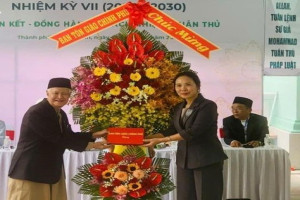
Every dawn, silent lines of saffron-clad Lao monks walk down the streets, to collect alms and opening their new day. They are barefoot for walking single file, oldest first, carrying their alms bowls in front of them.
Morning Alms is a longstanding tradition in Laos Buddhist culture. The practice of offering food to monks is most visible in a Theravada Buddhist country like Laos. The idea of the alms collecting is for the Buddhist monks to make merit and also to collect food for their one meal of a day.

Every morning, locals in Pakse province prepare to get up early, ready with bowls full of cooked food to offer to mendicant monks. Buddhism has long been a strong force in Lao culture and remains a major influence in everyday life.

Most devotees wear a scarf by crossing over the left shoulder

Almsgivers in Champasak province. They are also barefoot and kneeling with arms folded in front of chest when offering alms

Alms including small sticky rice, self-made cakes, fruits, ready-to-eat biscuits, canned milk, fresh milk, sometimes accompanied by a money sheet, etc are placed in a high-legged metal bowls with delicate motifs

According to the precepts of the original Buddhism, Buddhists are only allowed to offer cooked foods. That is why Theravada Buddhist temple does not have a kitchen

The monks pass one by one in front of the devotees and the faithful, at the same time, delivered the offerings with their own hands by inserting food inside the bowl that the monks carry. The daily procession is done in silence; the almsgivers do not speak, nor do the monks. The monks walk in meditation, and the almsgivers reciprocate with respect by not disturbing the monk's meditative peace. Women must keep their heads lower than the monks at all times.

The monks hang a shoulder bag for keeping the offerings of devotees.

After receiving the offerings from the faithful, Buddhist monks will pray for almsgivers while devotees bowing with one raising hand in front of their chest like a lotus flower. By feeding the monks the lay people generate good karma and the monks grant merit to the devotees that counts towards their future lives.

After the ceremony, Buddhists in Khon village, Champasak province’s Chawmpasak district attach sticky rice balls on the fence around the house for feeding birds

This custom seems similar to the custom of offering to all the sentient beings of the North Vietnamese but more practical

Monks in Laos only go for collecting alms before 12 noon, only take cooked-food from no more than seven families, regardless of how dilicious the food is, or how the almsgiver is rich or poor, do not stand in front of the market, and have one meal throughout the day before noon

Due to livelihood or poverty, many Buddhists can not go to the temple for making offerings as they wish. So, by accepting foods of all people without any discrimination, the alms giving ceremony creates equality for all Buddhists when they want to offer to the Three Jewels

Collecting alms are usually divided into four parts, one for their initiates if they have no or less offerings, one for the poor, one for pets such as dogs and cats, and the rest for mendicant monks

Like all Laotians, Buddhist monks use their hands to pick up food without using chopsticks, spoons or forks.
DT (vietnamnet.vn




